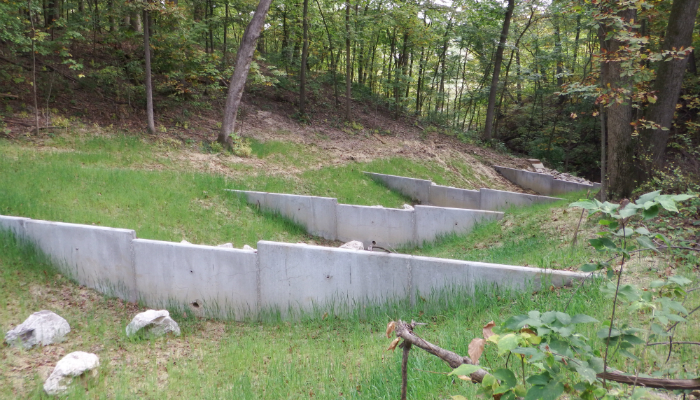Check Dams, a Great Concept for Gully Management, Often Badly Implemented

In a previous blog (Honeysuckle Brush for Erosion Control and Habitat) I mentioned that for little gullies in small watersheds, packing the whole gully with brush and branches is a relatively simple and effective means of slowing the water and keeping the gully from deepening. But I have since been asked what to do if the watershed is larger, or produces excess runoff from rooftops and pavement. With big flows, packed brush will simply float and do nothing to control erosion.
What does work, if done well, is a chain of check dams spaced down the gully, each one momentarily slowing the flow before it spills into the pool of the next one downstream.
Check dams have been built from almost everything imaginable, including sheet metal, staked brush bundles, wads of barbed wire, live willow sticks, boards, stumps, cement blocks, boulders, logs, staked burlap sacks, sandbags, poured concrete, etc. And many have failed soon thereafter, sometimes with the first heavy rain, when the water undermines them or fills them with sediment or simply washes them away in its mad rush to the sea.
In order to prevent such failures, four criteria must be met:
- Each individual dam must be set firmly enough in the ground that floodwater cannot undermine and bypass it.
- The top of each dam needs a shape which keeps the main overflow centered, and away from the sides, usually a notch or a broad “v.”
- The base of each dam, on its downhill side, needs protection from spillover erosion, usually an apron of large rocks.
- And what is most commonly overlooked is the need for all the check dams to form a chain placed head-to-toe, meaning that the base of each dam must be level with the top of the next dam downstream. In a steep gully this is many dams, close together. For example, if your short and steep gully has a “drop” of 30 feet and your dams are two feet tall, you need about 15 of them along the way. But if the gradient of the valley is gentle, for example like my Iowa City South Sycamore project, the low dams can be hundreds of feet apart – mine were broad earth dams, lightly armored, and 18 inches high.
The photo shows a proactive example in Coralville, where a large rooftop and large parking lot will discharge down a little ravine. This is a head-to-toe chain of a dozen concrete dams, max three feet high, with a centering notch. The little hole in the bottom center of each dam will allow it to slowly drain down completely. The ravine sides have since been planted with native shade-tolerant shrubs, and the dams will gradually disappear from view. Designed by Judy Joyce at Earthview Environmental, I expect these to perform well for many years with little maintenance.
Tags: check dams, erosion, Lon Drake

